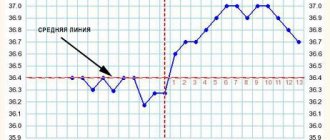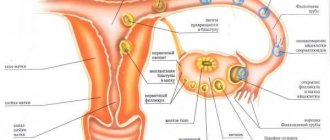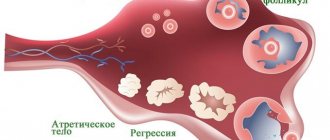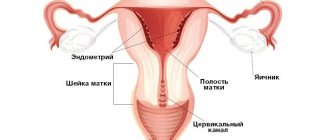It's a rare woman who doesn't want to have children. Wanting to achieve pregnancy, many representatives of the fair sex resort to all sorts of tricks: they follow proper nutrition and lead a healthy lifestyle, go to different doctors, have intercourse with their partner more often and carefully track the moment of ovulation in the menstrual calendar.
We all know: in order for a woman to become pregnant, it is necessary to allow two components to merge together in her body: the female egg and the male ejaculate.
Initially, the female egg matures in the body in the form of a small vesicle - a dominant follicle. After final maturation, this follicle in the ovary ruptures, and the finished reproductive cell begins its movement towards the uterus, where at the entrance to this cavity it meets the ejaculate.
If everything goes well, and the male reproductive cell merges with the female one, then the woman becomes pregnant, and the fertilized egg in her body is implanted into the uterine cavity, where it continues to grow and develop. If fertilization does not occur, then the female egg is subsequently excreted from the body in the form of menstrual flow, and the entire process of maturation of a new germ cell in the body begins anew.
Touching upon the question of what ovulation is, we can characterize this process as follows: ovulation is that moment in the menstrual cycle when a mature egg enters the uterine cavity, and it lasts literally several hours. Ovulation, in most cases, occurs in the middle of the menstrual cycle. It is during this short period of time that a child can be conceived.
A process in the female body such as ovulation is often accompanied by a large amount of viscous discharge such as egg white, by which a woman can determine this prosperous period for conceiving a child or designate for herself a time when it is not worth exercising if, on the contrary, she does not want to get pregnant .
Features of cervical secretion
Discharge is observed throughout the menstrual cycle. The quality of mucus depends on the phase. Each phase is regulated by the activity of various hormonal substances.
During the first phase, estrogen is considered the main hormone. It promotes the activation of the ovaries and the formation of endometrial tissue. Also, under its influence, the activity of the glands of the cervical canal begins. They produce mucus. Channel secretions perform a protective function. In the first days after menstruation, the glands secrete a small amount of fluid. It clogs the channel. This period is called dry.
An increase in the volume of discharge occurs with the production of follicle-stimulating hormone. This substance promotes the growth of the follicle involved in ovulation. Also, under its influence, the cervical glands increase the production of secretions. During this period, the woman notices small, scanty white discharge. The consistency of the secretion is thick.
The onset of the fertile period is characterized by the production of a luteinizing substance. Under its influence, the growth of the dominant follicle is activated. From this moment on, the secret changes its characteristics. The volume of cervical discharge increases. The secret is liquefied. Its structure takes on the properties of egg white. When squeezed between the fingers, the discharge can stretch greatly. Color varies from whitish to transparent. It is during this period that a woman realizes that ovulation is approaching.
The favorable phase has a short duration. The viability of the egg is one day. During this time, conception should occur. After the death or fertilization of the germ cell, estrogen gives way to progesterone. Under the influence of progesterone, the cervical canal closes. The discharge becomes thick. Their density increases. This quality is necessary for the formation of a dense plug. It serves as a protective barrier against a variety of pathogens. To prevent infection from affecting the fetus, a plug is needed. At this stage, the discharge disappears and small drops of a thick, white, odorless liquid appear.
By these qualities, many patients determine the onset of various phases of the menstrual cycle. But these symptoms do not always appear. Some women may have no discharge. In this case, you should be guided by additional signs of the ovulatory period.
Symptoms of the beginning of the fertile period
If a woman does not have discharge during ovulation, you need to pay attention to additional symptoms. The onset of the fertile stage can be detected by the following characteristic signs:
- increased sexual activity;
- soreness of the mammary glands;
- nagging pain in the area of the active ovary.
Before ovulation, an increase in luteinizing substance is observed. It promotes the growth and rupture of the dominant neoplasm. The substance is produced in the pituitary gland. This part of the brain is responsible for the development of sexual activity and reproductive function of women. With an increase in luteinizing hormone, the nerve endings of the cortex are irritated. For this reason, a woman experiences sexual desire. This feature of the body is observed 2–3 days before ovulation and throughout the entire fertile period. After ovulation ends, sexual activity decreases.
During the growth of luteinizing substance, the level of prolactin increases. The hormone helps the mammary glands prepare for feeding. Milk is produced in the glands due to the high content of prolactin. Before ovulation, prolactin causes minor changes in tissue. The breasts increase in size and may become painful. Soreness appears due to the expansion of the glandular ducts necessary for the excretion of milk. After prolactin decreases, the pain gradually goes away on its own.
In the absence of discharge, it is recommended to pay attention to discomfort in the lower abdominal cavity. Pain occurs in the area of the triggered ovary. The symptom occurs during the period of rupture of the walls of the dominant follicle. Also, unpleasant sensations can accompany the contractile activity of the uterus. Contraction is necessary to move the reproductive cell towards the uterine cavity.
Based on all subjective signs, a woman can determine the onset of ovulation. But these symptoms are typical for all women. If a favorable day passes without discharge, you should use home methods for detecting ovulation.
What do doctors say on this topic?
Doctors assure that if there is no discharge during ovulation, there is no need to be upset and depressed. Practice shows that signs of ovulation are absent in a considerable number of women. And there is also the opposite situation, when discharge appears, but conception does not occur, so you should not worry at the first negative change.
Although vaginal dryness during the coveted period is not considered uncommon, it should not be ignored. Doctors say that if such problems occur in the body, there is no need to hesitate to go to the hospital, as otherwise the situation may change for the worse.
If a woman is completely healthy, she may, of course, have no discharge during and after ovulation, but not for too long. You will need to seek help from a medical facility if you notice the following signs:
- sharp specific odor in the vaginal area;
- the discharge has a greenish or grayish color;
- mucus appears for a long time;
- discharge occurs along with pain;
- burning and itching appears in the genital area;
- the mucous membranes of the reproductive organs began to crack.
Home methods for detecting fertility
If the fertile phase occurs without discharge, you need to use a home method. The following methods are offered to detect ovulation:
- use of special test strips;
- use of a microscope;
- building a graphic table of basal temperature.
A common method is to use special test strips. The test can be purchased at your nearest pharmacy. The package contains 5-7 strips for one-time use. Using the tests is simple.
The first use should occur on days 7–9 of the menstrual cycle. The date depends on the length of the cycle. The lower it is, the earlier you need to use the test. The study is recommended to be carried out after 10 o'clock. During this period, the highest concentration of luteinizing hormone is observed. The test has two zones: control and study. The control zone is saturated with a substance that reacts with urinary fluid. It is constantly painted in a bright color. The area being tested can only come into contact with luteinizing hormone. The intensity of coloring depends on the amount of hormone. The more substance is contained in a woman’s urine, the brighter the field under study is colored. A positive test is considered to be uniform coloring of both zones in the same tone. From this moment on, ovulation should occur in a day.
The microscope has the greatest accuracy. It can also be purchased at a pharmacy. But it has a high cost. The price of a microscope ranges from 3 thousand to 5 thousand rubles. The study is carried out using saliva. It has been found that a woman's salivary fluid also responds to changes in the level of luteinizing substance. With a significant increase in the level of the hormone in the studied area, an image resembling a clover leaf is detected. If a woman finds such a picture, but no discharge appears, ovulation occurred on that day.
It should be understood that these methods are based on the amount of hormone. The growth of a hormonal substance is not always accompanied by rupture of the follicle. To understand whether the egg has been released, it is necessary to plot the basal temperature. Correct construction of the graph allows you to fully see the course of all phases of the menstrual cycle.
How to make a schedule correctly
To build the curve, a woman should measure her basal values every day after sleep. The thermometer is placed in the rectum for several minutes. The obtained data is entered into a table. Each result is placed along a horizontal line. The height of the point is regulated by a vertical ruler of temperature indicators. Connecting the dots gives a graphical picture of the menstrual cycle.
It is easy to determine ovulation using the chart. On the day of the luteinizing substance surge, a sharp decrease in basal temperature is observed. This period is called sinking. Ovulation should occur the next day. When the follicle ruptures, the indicators increase. The temperature difference can reach 1 degree. If, after sinking, the curve does not rise, there was no ovulation in this cycle.
Medical method for determining a favorable period
If a woman passes a favorable day without discharge, she should seek help from a specialist. He will offer a method carried out in a medical setting. This method is called folliculometry. It is carried out using an ultrasound diagnostic device.
The doctor conducts the first examination one day after the end of menstruation. The specialist needs to study the thickness and growth rate of the endometrial layer. The functioning of the ovary is also being studied. After identifying the dominant, a repeat examination is carried out a day later. Only this method allows us to state with certainty that ovulation can occur without cervical discharge.
What conclusions can be drawn?
The absence of discharge during and after ovulation signals both the development of serious illnesses and simple hormonal imbalances that occur due to stress or poor lifestyle choices.
If a woman is planning a pregnancy, then if there are any changes in the body, she needs to consult a doctor to identify the cause and begin therapy. Other ladies would also benefit from timely diagnosis, because vaginal dryness sometimes indicates the appearance of chronic diseases associated with the reproductive system, which is not very good for health in general.
Pathological causes of secretion disorders
In most patients who ovulate without discharge, this is not a sign of pathological damage to the reproductive system. But in some cases, secretion is disrupted for negative reasons.
The following possible health problems are being considered:
- violation of the level of hormonal substances;
- infection of the vaginal microflora;
- stressful conditions;
- use of intimate cosmetics.
Lack of discharge may occur due to hormonal imbalance. The liquefaction of the secretion depends on the growth of the follicle-stimulating substance. At its low level, the secretions do not change their properties. In this case, ovulation occurs without the appearance of mucus. Also, the loss of a secret is accompanied by the absence of an auspicious day. In this case, background failure affects the activity of the ovaries. The growth and development of the follicle does not occur in the proper order. To detect pathology, a woman needs to visit a medical center.
The problem may also be infection of the vaginal microflora. Normally, a healthy woman’s microflora consists of beneficial and opportunistic microorganisms. These bacteria serve to protect the delicate tissues of the reproductive system. Under the influence of various negative factors, microflora can change its constant composition. In this case, opportunistic bacteria are activated. They have a detrimental effect on beneficial microorganisms. In this case, the lumen of the cervical canal decreases. This feature helps prevent the spread of infection in the uterine cavity.
Infection can be identified by additional symptoms. With negative disorders, an unpleasant odor appears from the vagina. There is also itching and burning in the genital area. If such a symptom appears without visible discharge, you need to consult a doctor.
The reason for the lack of discharge may be a stressful situation. When exposed to stress for a long time, the pituitary gland stops producing normal amounts of hormones. Adrenaline occupies the main place. It blocks the activity of the reproductive system. To eliminate the unfavorable factor, you need to visit a psychologist. It will help you get rid of stress.
Additional factors
In modern women, a common cause is the use of intimate cosmetics. Lubricants have become widespread. They serve as a substitute for natural lubricant. These products contain various chemical components. Glandular tissue may react negatively to certain components of the product. In this case, the canal stops producing natural mucus. Discharge disappears during ovulation. Intimate care products can have the same effect. If the use of a new detergent is accompanied by a change in natural secretion, it is necessary to abandon it.
Any of these factors causes disruption of the natural functioning of the glandular layer of the cervical canal. To restore the functioning of the organ, it is necessary to establish the cause of the pathological changes. Only then can you get the right help from a specialist.
Ovulation is an important component of pregnancy planning. Women carefully monitor all changes occurring in the body during this period. The disappearance of discharge often causes panic. Don't be afraid. You need to see a specialist and undergo an examination. In many cases, this phenomenon refers to a sign of normal activity of the cervical canal. If the cause is organ damage, the doctor will prescribe effective treatment. After completion of therapy, planning can be resumed.
What measures should be taken in this case
When it becomes clear that there is no discharge during ovulation, there is no need to immediately start panicking. First of all, it is recommended to clearly determine the cause of the violations, which can only be done after undergoing certain tests in the hospital. As a rule, this phenomenon does not act as a pathology, although even in this case the doctor will have to find out the cause and prescribe therapeutic measures. The main thing to remember is that only after treatment will it be possible to calmly plan a pregnancy.
In addition to the above, it is important to understand that the body must be carefully monitored, recording all changes. And it is possible to recognize the approach of ovulation by other secretions that appear some time before this period and several days after it.
Even more interesting:
Tongue with HIV infection photo
Yarina or Dimia
Before ovulation, the discharge is characterized by transparency or a whitish tint, and after it the mucus becomes thicker and acquires a rich color. If the tone of the discharge fluctuates between yellow and white, this signals the normal maturation of a new egg.
Is pregnancy possible when there is no discharge during ovulation?
It happens that there is no discharge during or after ovulation, but later pregnancy occurs. This should not be surprising, since this process is explained by doctors as follows: the entry of the partner’s sperm into the uterus becomes more difficult, but is not completely blocked, so fertilization is quite possible.
The absence of discharge does not mean that ovulation does not occur, and certainly does not signal that the woman is infertile.
As for pregnancy, it usually occurs during the open “fertile window” (five days before the release of the egg and after this process).










